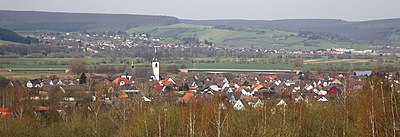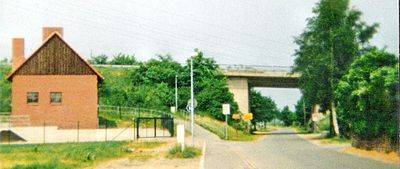Weser Bridge (Lüchtringen)
Coordinates: 51 ° 47 ′ 38 " N , 9 ° 25 ′ 39" E
| Lüchtringen bridge over the Weser | ||
|---|---|---|
| use | Road and pedestrian bridge of the K 46 to the B 64 and connection to Holzminden-Süd | |
| Crossing of | Weser | |
| place | Lüchtringen | |
| construction | Haunted girder / girder bridge | |
| overall length | 180 m | |
| width | 14 m | |
| Longest span | 87 m | |
| building-costs | 11 million DM | |
| start of building | 1973 | |
| completion | 1977 | |
| opening | 1977 | |
| location | ||
|
|
||
The Weser Bridge in Lüchtringen connects the Lüchtringen district with the core town of Höxter and in the extension of the district road 46 to the federal road 64 / federal road 83 .
history
As part of the preliminary negotiations on the area change agreement of December 19, 1968, according to which the former municipality of Lüchtringen was merged with the city of Höxter, the municipality asked for a better road connection between the village and the regional road network. The civil engineering department of the Höxter district, under the direction of chief building officer Hans Mussenbrock, was commissioned with the investigation and planning and proposed as a solution to build a new bridge over the Weser to replace the Lüchtringer Weser ferry, which is no longer up to date. The aim here was not only to connect the town of Lüchtringen to the network of long-distance roads, but also to create a direct and shorter connection between the neighboring district towns of Höxter and Holzminden. However, a flood-free connection through the wide Weser valley was not considered for the then Höxter district for cost reasons, so that in addition to the Weser bridge and a bridge in the area of a flood basin, a section of the road had to be planned as a flood route for a few days a year as a flood route during the highest floods. This restriction was considered acceptable by all those involved, especially since one of the directly adjacent road bridges was considered flood-free.
Planning began on October 14, 1969, and the plan approval procedure was initiated in December 1971. The plan approval decision was made on September 13, 1973 and became legally binding on October 18, 1973.
The groundbreaking ceremony took place on November 9, 1973 by District Administrator Alex Brunnberg . At the same time, the construction of the district road 3364 (today K 46) as well as the flood bridge and two smaller bridges took place. The construction costs were funded according to the municipal financing law and amounted to 11 million DM. 60 percent of these were paid by the federal government, 25 percent by the state of North Rhine-Westphalia and 15 percent by the district of Höxter (1816–1974) or after the district reform from 1975 onwards from the new District Höxter worn.
The Lüchtringer Bridge was opened to public traffic on December 15, 1977. On December 18, 1977 the ferry service (car ferry) in Lüchtringen was stopped. The last ferryman was Fritz Krekeler.
In the 1980s, the bridge was often included in military maneuvers during the Cold War due to its military load class . She received the highest bridge class at the time with 60/30, i.e. H. In addition to evenly distributed area loads, a heavy truck with a total load of 60 t (SLW 60) was possible in the main lane and a total load of 30 t in the adjacent lane.
In November 2012, the district building authority announced that around 7,300 vehicles were on the route in 24 hours and that district road 46 was therefore considered to be very busy. Both the Weser bridge and the flood bridge are in need of renovation due to cracks, rust on the guardrails and deep ruts in the road surface. The need for renovation is estimated at one million euros and work is to start in 2013. To avoid accidents due to aquaplaning, the speed across the bridge had to be reduced from 100 km / h to 70 km / h. The renovation was completed in 2015.
location
The Weser Bridge from Lüchtringen connects as Kreisstraße 46 (formerly Kreisstraße 3346) the north-eastern part of the city with the city center of Höxter and continues to the southern part of the Lower Saxony district town of Holzminden . From the bridge, in the extension of the county road, a junction leads south to the UNESCO World Heritage Site Corvey Castle and further below the Räuschenberg to the federal road 64 . A confluence leads to Lüchtringen and in a northerly direction the route leads into the small industrial area of Lüchtringen and the industrial area of Holzminden-Süd.
The Weser Cycle Path also runs along the Weser and below the bridge .
description
For the first time in Germany, a new process was used for completion. Then, parallel to the course of the river, the two approx. 3000 tons heavy, 80 m long and 14 m wide prestressed concrete girders were erected and rotated by 90 ° over the Weser in several hours using a pivot bearing and gaps between the abutment and the superstructure were filled with concrete. With this procedure, no falsework had to be set up, which would also have hindered shipping on the Weser .
The prestressed concrete bridge connects the right bank of the Weser and the left foreland or the agricultural areas near Corvey. It is 180 m long and 14 m wide. The span is 87 m.
There is also the extension of the Weser-Flutmulde (flood bridge) with a length of 90 m and a small bridge over the Lange Strasse in Lüchtringen of 9 m near the pumping station built in 1991.
literature
- Brief information on the new construction of the 3346 district road with the Weser bridge between Höxter and Lüchtringen. A message on the occasion of the inauguration of the new Weser Bridge on December 15, 1977 online (PDF; 124 kB)
Web links
- To the Weser Bridge in Lüchtringen (PDF; 124 kB)
Individual evidence
- ↑ http://www.hvv-hoexter.de/wp-content/uploads/2011/07/Weser%C3%BCbergang-L%C3%BCchtringen.pdf
- ↑ M136 - 50 years of maneuvering history ( Memento from January 16, 2013 in the Internet Archive )
- ↑ Lit .: Use of the rotary construction method in the construction of the Weser bridge Höxter-Lüchtringen, civil engineer 4, M. Specht, G. Powitz, B. Piedrigkeit, Springer-Verlag, Berlin 1977



